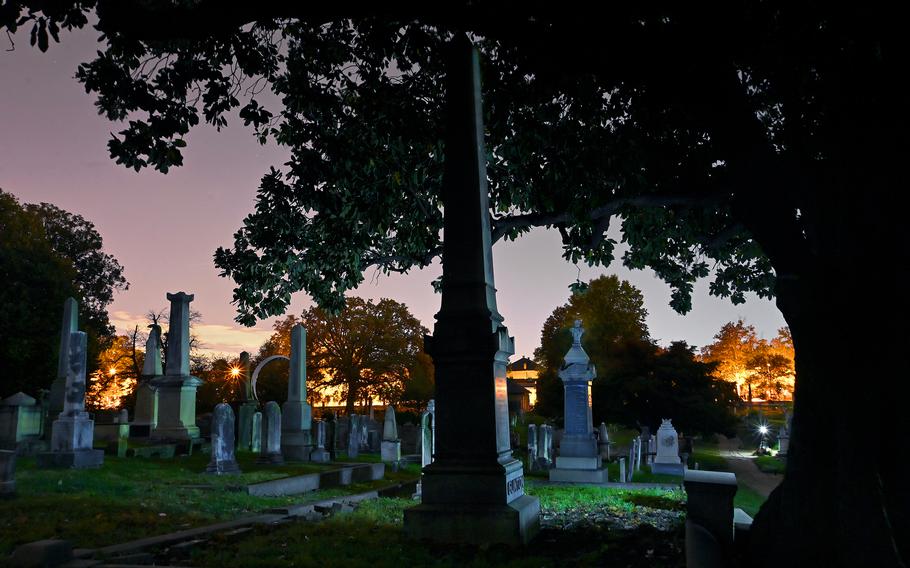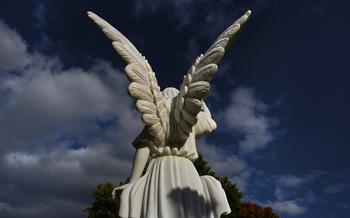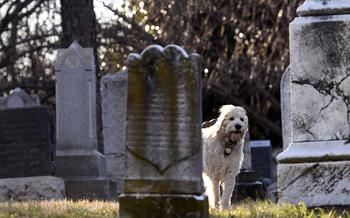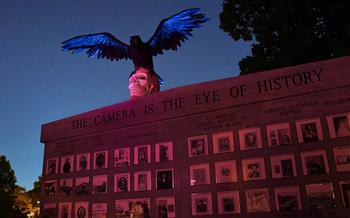
The sun goes down in Congressional Cemetery, Washington, D.C., on Oct. 18. (Michael S. Williamson/The Washington Post)
When Traci Rylands plans a vacation, she always weaves cemeteries into the family’s travel itinerary. On a July trip to upstate New York, she explored 10 burial grounds over a week. For an upcoming road trip to Florida, she warned her husband and teenage son that they would be stopping at cemeteries on the way down — and back. And, after 10 years as a tombstone tourist, she recently set a new personal best: a dozen cemeteries in a day.
“It’s not just about a bunch of dead people. It’s art, architecture, stones from different eras, horticulture, flowers, trees and birdwatching,” said the Atlanta resident who created the blog Adventures in Cemetery Hopping a decade ago. “I can look beyond the zombies and find something cool about history.”
For cemetery hoppers — or more properly, taphophiles — cemeteries are not simply resting places for loved ones or fertile ground for horror stories. They are destinations that combine the art and history of museums; the flora and fauna of parks; and the pop culture and fandom of celebrity-home tours.
“Some people come here for the proximity to famous people. Jazz aficionados want to see Miles Davis and Duke Ellington. People who are interested in women’s rights want to see Carrie Chapman Catt and Elizabeth Cady Stanton. And lately it’s been ‘The Gilded Age’ TV show,” said Susan Olsen, director of historical services at Woodlawn Cemetery and Conservancy in the Bronx. “All the characters are buried here.”
Are you a taphophile?
Most travelers are accidental taphophiles. If you’ve ever visited Père-Lachaise in Paris, Bonaventure in Savannah, Ga., or St. Louis Cemetery No. 1 in New Orleans, you qualify. To advance to the next level, you just need to visit more cemeteries and graveyards, which is easy to do considering they’re everywhere. In 2018, Joshua Stevens, a cartography and data visualization expert at NASA’s Earth Observatory, mapped out nearly 145,000 burial grounds in the contiguous United States.
“On vacation, I will walk around town and stop at any cemetery that catches my eye,” said Steve Stern, a New Jersey retiree and amateur genealogist who posts his research on Find a Grave. “I find them fascinating.”

A stone angel watches over the graves at Congressional Cemetery in Washington, D.C. (Michael S. Williamson/The Washington Post)
Taphophiles usually downplay, if not outright dismiss, the creepy factor of cemeteries. Olsen said ghosts will typically haunt their former residence or workplace, not their final resting site. She used Olive Thomas Pickford, one of Woodlawn’s 320,000 “residents,” to demonstrate her point. The Ziegfeld Follies chorus girl, who fatally ingested her husband’s syphilis medicine in 1920, causes mischief inside Broadway’s New Amsterdam Theater. But when she’s at home in her mausoleum, she’s as quiet as a silent film actress.
“I haven’t had many spooky experiences, which I am happy and sad about,” said Loren Rhoads, author of “199 Cemeteries to See Before You Die.” “Nobody has ever grabbed my foot.”
Around Halloween, a number of cemeteries will raise a few hairs with events that illuminate the sometimes dark and tortured backstories of the buried. Washington, D.C.’s Congressional Cemetery, for one, organizes “Murder and Mayhem: Tragic Deaths at Congressional Cemetery” walking tours. Volunteers in period dress channel the personalities residing in the 19th-century Cedar Rest Cemetery in Bay Saint Louis, Miss. Docents also don costumes on the Capturing the Spirit of Oakland tour in Atlanta. However, the Georgia cemetery reassures the easily spooked that the tour is “designed to enlighten rather than frighten.”
“Cemeteries are a place of joy and a celebration of the dead,” said Mary Margaret Fernandez, program outreach coordinator with the National Trust for Historic Preservation. “They tell the story of people.”
Cemeteries as playgrounds for the living
Long before Carrie’s hand pushed through the fresh dirt like a crocus in the 1976 horror film, burial grounds doubled as pastoral playgrounds for the living. Victorians, who popularized the trend in the 19th century, would picnic, read poetry and frolic in the tombstone-studded green spaces.
“They were designed for recreation, as public parks,” Fernandez said of “rural” cemeteries.
Père-Lachaise, which opened in 1804 and attracts more than 3.5 million visitors a year, according to the Paris Convention and Visitors Bureau, sparked the movement. The garden-style design soon spread across the English Channel and the Atlantic. In the United States, Mount Auburn in Cambridge, Mass., is the earliest example. It opened in 1831 under the creative direction of Jacob Bigelow, a Boston physician and botanist who calls the cemetery his forever home.
In addition to appealing to garden buffs and afternoon loafers, cemeteries also began to attract fans wishing to commune with their dead idols, such as Jim Morrison and Edith Piaf in Père-Lachaise; members of the Allman Brothers Band at Rose Hill Cemetery in Macon, Ga.; and Judy Garland and Rudolph Valentino at Hollywood Forever in Los Angeles.
“In life, you may never have been able to meet them,” Rhoads said, “but you can stand at their grave and say thank you.”
Out of respect for residents and their loved ones, many cemeteries limit the activities permitted inside their gates. Mount Auburn doesn’t allow biking, running, dog-walking or picnicking. St. Louis Cemetery No. 1 prohibits two New Orleans staples — food and booze. Bonaventure has an incredibly specific rule: No sitting on Conrad Aiken’s bench and drinking a bottle of wine with the Savannah author and poet laureate.
Being a tombstone tourist
I read Rhoads’ book. Consulted with taphophiles. Downloaded cemetery apps. Joined the Find a Grave community, whose members taught me to never ask a vague question like, “Can you recommend a city with a large concentration of interesting cemeteries?”
First rookie mistake: I should’ve included the country.
“We would also need to know what you want to do when you visit — take photos of interesting monuments? Visit Famous graves? Document military burials? Fill photo requests? Mow the rows? Try to decipher old worn monuments? Or just sit and commune with the souls of the departed?” a member named RosalieAnn replied.
I narrowed my options down to three destinations before settling on New York City, plus a trial run in Congressional Cemetery in my home base. (Savannah and Boston were the runners-up.)
“BEWARE . . . All souls who enter here,” read a sign at Congressional Cemetery’s main gate, setting a tone that was more “Scary Movie” than “Night of the Living Dead.” “Well that sounded spooky, but this is an historic yet active burial ground so enter at your own risk.”
The line under the warning further lightened the mood: “MUST LOVE DOGS.” The cemetery allows dogs to run off leash, and owners must be members of its K-9 Corps. However, the wait list is so long, the cemetery has paused registration. Instead of waiting four to five years, I purchased a $10 dog pass for Lunchbox. (Humans are free.) I also grabbed several themed tour brochures with maps: Introductory, African Americans and LGBT Community.

Buster, a labradoodle, takes a break from playing while walking through Congressional Cemetery in Washington, D.C., in February 2017. (Toni L. Sandys/The Washington Post)
We set out for the tomb of composer John Philip Sousa. However, our quest was frequently interrupted by the free-roaming dogs eager to befriend Lunchbox and the gravestones along the route that compelled me to stop for a private conversation.
“Go say hi to our friend Dennis,” a couple called out to us.
I circled back to W. Dennis Grubb, one of the Peace Corps’s first volunteers, who served in Colombia in 1961, the year the organization was established. I added Dennis to my guest list of six people, dead or alive, I would invite to dinner. With several more cemeteries to go, I would need more seats at the table.
The city that sleeps
I arrived at Trinity Church Wall Street a half-hour before the 6 p.m. closing time and 15 minutes before the guards would start shooing people out. Fortunately, the graveyard is not much larger than a suburban backyard, and the main attraction — Alexander Hamilton’s grave — stands heads above the other stones. His wife, Eliza, rests at the foot of the memorial, and a plaque dedicated to his son flanks his left side. I stretched my neck over the chain barrier to read the sign, which explains that Hamilton and Philip, his eldest, share the same cause of death: by duel.
The churchyard dates to 1697, and many of the graves are cracked or keeling, their inscriptions eroded to the point of illegibility. I noticed a box grave with a large gap that a body could easily squeeze through.
“I think someone escaped,” I told security on the way out.
“Don’t worry, we’ll push him back in,” a guard replied.
Burial space, like subway seats during rush hour, is limited in Manhattan. However, in the other boroughs, the living and the dead have room to stretch out. Green-Wood, which occupies the site of the Battle of Long Island of 1776, covers 478 acres. In the mid-1800s, the cemetery was the country’s second-most popular attraction after Niagara Falls, drawing half-a-million visitors a year.
On a recent Tuesday morning, I entered the Sunset Park entrance with a woman pushing a stroller and immediately lost the pair among the gentle hills and winding paths named after flowers and trees. At the Gothic Arch, which frames the main entrance, I waited with a binocular-wearing couple for the monk parakeets to make an appearance.
“It’s New York, so sometimes the birds sleep in,” said one of the birders, as we scanned the nest high in the spire for flashes of neon green.
I bumped into the largest gathering of people at Jean-Michel Basquiat’s grave: Three friends who used a hiking trail app to find the artist’s site, which was surprisingly unremarkable.
Cemeteries discourage guests from leaving gifts, which can damage the grave. But, as expected, the neo-expressionist’s subversive fans placed several items on and around his stone marker, including a Pokémon card, an empty mini-bottle of tequila and a notebook with an apology: “They made your art shirts at H&M. I’m sorry.”
I emerged from Green-Wood several hours later and rode the subway with Yankees fans to the Bronx, home of Woodlawn. The 400-acre cemetery is only a mile long from end-to-end. However, with closing time nearing, I hopped on a trolley tour narrated by Olsen.
“What always tickles us are the pilgrimage folks,” she said. “It used to be Miles Davis, but now it’s the Gilded Age folks.”

There’s a large display where Civil War photographer Mathew Brady is buried at Congressional Cemetery in Washington, D.C. The memorial features a stone wall with Brady’s photos and a raven sitting on a skull overlooking the memorial, acknowledging the portraits Brady did of Edgar Allan Poe. (Michael S. Williamson/The Washington Post)
As we cruised by a fraction of Woodlawn’s 1,321 mausoleums and 125,000-plus monuments, she rattled off the personalities with the biggest fan bases: Davis and Ellington, both of whom occupy the Jazz Corner; Herman Melville, whose admirers leave pens, whale trinkets and tattered copies of “Moby Dick;” Celia Cruz, the Cuban-born “Queen of Salsa;” and Dorothy Parker, whose ashes languished in a Baltimore filing cabinet before they were moved to a resting place beside her parents and grandparents.
“We love it when the last chapter is all about us,” said Olsen as the trolley rolled forward, on the road to the eternal.